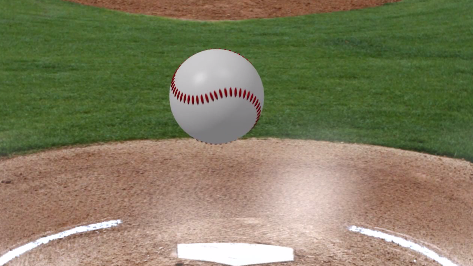
Professional baseball pitchers are able to make a baseball move left, right, down, and even up (sort of) to get it by the opposing batter. The physics behind this can be explained by the Magnus effect.
It’s All in the Spin
After leaving a pitcher’s hand, a baseball pitch is influenced by three forces: gravity, drag, and the Magnus force. Gravity pulls the ball downwards, drag slows the ball down, and the Magnus force… Well, that depends on the pitch. As the ball spins in its flight path, pressure variations form on it and the Magnus effect generates a force perpendicular to the motion of the ball in the direction of the spin. For a more detailed explanation of how the Magnus effect works, check out my colleague Ed Fontes’ great explanation in a related blog post on curving a soccer ball.

In baseball, a pitcher has more control over the spin of the ball than in any other sport. A pitcher can spin the ball to add topspin, backspin, or sidespin depending on the pitch they want to throw. The degree of difficulty in throwing each pitch varies based on the spin. The margin of error is lower as the difficulty rises.
Breaking Down the Pitches
Fastballs
Fastballs are the easiest pitches to throw as they are only slightly affected by the Magnus force. A four-seam fastball is a pitcher’s main pitch, thrown the most often. There is a natural tendency to add backspin to the ball as it is released. The backspin points the Magnus force up, causing the ball to fall slower than other pitches, imparting the illusion that the ball is rising. Other fastballs, such as the two-seam and cutter, are thrown with spin, but are moving too fast for the Magnus effect to change their position drastically.
Fastball. Thrown by a right-handed pitcher, as seen by the batter. Baseball geometry created using COMSOL Multiphysics.
Breaking Balls
Breaking balls are the pitches that most rely on the Magnus force to be effective. The curveball is the most important breaking ball and almost all starting pitchers in Major League Baseball (MLB) must have one in their arsenal. As the pitcher releases the ball, he snaps his wrist over the ball, putting immense amounts of spin on it. This causes the ball to break down and left diagonally (for a right-handed pitcher). If thrown correctly, the curveball can be devastatingly effective, causing the batters to look silly, either by making them swing at pitches in the dirt or even duck out of the way of pitches that end up in the strike zone.
Curveball. Starts outside and then curves in for a strike.
A slider is thrown with horizontal spin, causing the ball to break laterally (right to left for a right-handed pitcher). A screwball is thrown with similar spin to a curveball, except it breaks down and right instead of left (for a right-handed pitcher). There are other types of breaking balls that pitchers employ, but they are mainly variations of the pitches described here. For example, a 12-6 curveball breaks straight down, without any lateral movement.
Slider. Looks like a fastball before sliding away out of the strike zone.
Screwball. Looks like a fastball before curving down and out of the strike zone.
The Knuckleball
The knuckleball is the most majestic pitch of all and the Magnus effect is actually its enemy. A knuckleball is ideally thrown to rotate just once on its way to the catcher. The lack of spin causes a Karman vortex street to be formed behind the ball, as explained by Ed in the World Cup™ blog post. The Karman vortex street causes tiny fluctuations in the ball’s movement, enough to throw off a hitter. In fact, with a great knuckleball, not even the pitcher can know where it will end up. If a knuckleball is thrown with too much spin, it will be easier to hit because the Magnus effect causes both uniformity in the ball’s movement and a straight ball path. When thrown correctly, the ball dances from side-to-side, as seen in this GIF.
The Key to Effective Baseball Pitches
The key to effective pitching is mixing the different types of pitches together to keep the batter guessing and off balance. A pitcher also has to mask the pitches as they are thrown, in order to not tip the batter off to where the ball is going.
Take a Closer Look at the Physics Behind Additional Sports
- Here on the COMSOL Blog, we feature a number of posts relating to the physics of sports. Browse them here.



Comments (0)